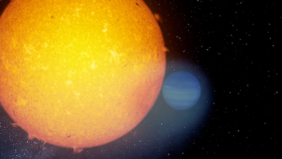An international team of scientists has again exploited the outstanding performance of the CARMENES instrument. The astronomers from Spain, Germany and the Netherlands show that the giant exoplanet WASP-69b carries a comet-like tail made up of helium particles escaping from its gravitational field propelled by the ultraviolet radiation of its star. The results of this work are published today in the journal Science.
The CARMENES instrument, which is installed on the 3.5-meter telescope of the Calar Alto Observatory near Almería (Spain), and which recently contributed to the spectacular detection of a planet orbiting Barnard’s star, made it possible to reveal the composition of the atmosphere of this exoplanet and to draw conclusions about the speed of the helium particles that leave the gravitational field of the planet and the length of the tail they produce.
The planet was observed during a transit, when the planet passed in front of its host star. During this event, the planet and its atmosphere eclipse part of the starlight. "We observed a stronger and longer lasting dimming of the starlight in a region of the spectrum where helium gas absorbs light," says Lisa Nortmann, a researcher at the Instituto de Astrofísica de Canarias (IAC) and lead author of the article published today in the journal Science. "The longer duration of this absorption allows us to infer the presence of a tail“, she adds.
The authors have also analyzed four other planets in a similar way, combined with data from the European Space Agency's Multi-Mirror X-Ray Mission (ESA XMM-Newton). The results indicate that helium is detected in the atmospheres of those planets that receive the largest amount of X-ray and extreme ultraviolet radiation from their host stars. The results of such studies could confirm that extreme radiation from the host star can strip the gaseous envelope of giant planets and turn them into rocky planets with densities similar to Venus or Earth.
"In the past, studies of atmospheric escape were based on space-borne observations of hydrogen in the far ultraviolet. CARMENES now allows studying such processes with ground-based telescopes in a much more cost-effective way”, explains Prof. Dr. Andreas Quirrenbach, director at the Landessternwarte Königstuhl (LSW) and responsible for the design and construction of CARMENES. “In addition, with CARMENES we can measure the velocity of the gas stream, which gives us valuable clues about the physical processes at work.”
This new line of research will enable the characterization of exoplanet atmospheres to compare the evaporation processes in a large sample of planets, and answer questions such as whether planets with ultra-short orbital periods are actually the evaporated nuclei of ancient hot Neptunes.
The CARMENES instrument was developed by a consortium of eleven Spanish and German institutions, led by theLSW, which is part of the center of astronomy of Heidelberg University. It was designed to search for terrestrial planets in the habitable zone of M-stars, the region around a star where conditions allow the existence of liquid water. The results published today demonstrate the ability of the instrument to contribute significantly to the research field of exoplanet atmospheres.
LOCAL CONTACT
Dr. Guido Thimm
Zentrum für Astronomie der Universität Heidelberg (ZAH)
Email: <link>thimm@uni-heidelberg.de
ORIGINAL PUBLICATION
Nortmann, L.; Pallé, E.; Salz, M.; Sanz-Forcada, J.; Nagel, E.; Alonso-Floriano, F. J.; Czesla, S.; Yan, F.; Chen, G., Snellen I. A. G.;Zechmeister, M.; Schmitt, J. H. M. M.; López-Puertas, M.; Casasayas-Barris, N.; Bauer, F. F.; Amado, P.; Caballero, J.; Dreizler, S.; Henning, T.; Lampón, M.; Montes, D.; Molaverdikhani, K.; Quirrenbach, A.; Reiners, A.; Ribas, I.; Sánchez-López, A.; Schneider, C.; Zapatero Osorio, M. R. (2018): <link http: science.sciencemag.org content early science.aat5348>Ground-based detection of an extended helium atmosphere in the Saturnmass exoplanet WASP-69b
FURTHER INFORMATION
- Salz, M.; Czesla, S.; Schneider, P. C.; Nagel, E.; Schmitt, J. H. M. M.; Nortmann, L.; Alonso-Floriano, F. J.; López-Puertas, M.; Lampón, M.; Bauer, F. F.; Snellen, I. A. G.; Pallé, E.; Caballero, J. A.; Yan, F.; Chen, G.; Sanz-Forcada, J.; Amado, P. J.; Quirrenbach, A.;Ribas, I.; Reiners, A.; Béjar, V. J. S.; Casasayas-Barris, N.; Cortés-Contreras, M.; Dreizler, S.; Guenther, E. W.; Henning, T.; Jeffers, S. V.; Kaminski, A.; Kürster, M.; Lafarga, M.;Lara, L. M.; Molaverdikhani, K.; Montes, D.; Morales, J. C.; Sánchez-López, A.; Seifert, W.; Zapatero Osorio, M. R.; Zechmeister, M. (2018): <link https: assert.pub papers internal link in current>Detection of He I 10830 Å absorption on HD 189733 b with CARMENES high-resolution transmission spectroscopy
- <link https: www.dropbox.com sh gmr52ebxlf1utgj internal link in current>Images and videos of artistic impressions of WASP-69b
- <link http: carmenes.caha.es internal link in current>Hompage of the CARMENES Consortium
- The CARMENES Consortium Institutes:<link http: www.mpia.de internal link in current>
Max-Planck-Institut für Astronomie, MPIA<link https: www.iaa.csic.es internal link in current>
Instituto de Astrofísica de Andalucía, IAA<link https: www.lsw.uni-heidelberg.de internal link in current>
Landessternwarte Königstuhl, LSW<link http: www.ice.csic.es en home internal link in current>
Institut de Ciències de l'Espai, ICE<link http: www.uni-goettingen.de en internal link in current>
Institut für Astrophysik Göttingen, IAG<link http: webs.ucm.es info astrof internal link in current>
Universidad Complutense de Madrid, UCM<link http: www.tls-tautenburg.de tls internal link in current>
Thüringer Landessternwarte Tautenburg, TLS<link http: www.iac.es internal link in current>
Instituto de Astrofísica de Canarias, IAC<link https: www.hs.uni-hamburg.de internal link in current>
Hamburger Sternwarte, HS<link http: www.cab.inta-csic.es en inicio internal link in current>
Centro de Astrobiología, CAB<link http: www.caha.es internal link in current>
Centro Astronómico Hispano-Alemán, CAHA
SPECIAL NOTES TO JOURNALISTS:
More information, including a copy of the paper, can be found online at the Science press package at www.eurekalert.org/jrnls/sci. You will need your user ID and password to access this information.

